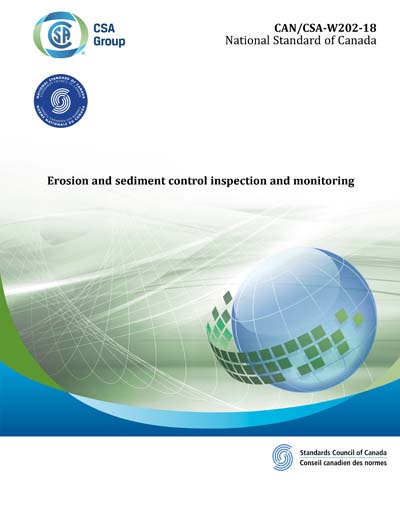Most recent
CAN/CSA W202-2018
Erosion and sediment control inspection and monitoring
Preface This is the first edition of CAN/CSA-W202, Erosion and sediment control inspection and monitoring. The purpose of this Standard is to provide requirements for the inspection and monitoring of erosion and sediment control measures installed on construction sites. Compliance with this Standard will allow users to demonstrate that erosion and sediment control measures are installed where they should be, functioning as expected, and that every reasonable effort is being made to prevent impacts to the environment and infrastructure surrounding the construction site. This Standard pulls from industry expertise and best practices in Canada and internationally to address the personnel qualification, communication and documentation, and the inspection and monitoring requirements associated with erosion and sediment control on construction projects. Users of this Standard are reminded that additional and site-specific requirements may be specified by federal, provincial/territorial, municipal or other authority, or by a project owner. This Standard should not be considered a replacement for the requirements contained in any a) applicable federal/territorial, or provincial statute; b) regulation, license, or permit issued pursuant to an applicable statute; or c) contract that an owner has with a contractor. This Standard has been developed in compliance with Standards Council of Canada requirements for National Standards of Canada. It has been published as a National Standard of Canada by CSA Group. Scope 1.1 General This Standard specifies minimum requirements for the inspection of ESC measures throughout the duration of a construction project, as well as requirements and recommendations for monitoring certain water quality parameters. It also includes a description of the required qualifications for a qualified erosion and sediment control inspector (QESCI) and a QESCI in-training (QESCI-IT). This Standard further details the required documentation and communication procedures to be followed with respect to erosion and sediment control inspection, monitoring, and other compliance measures. This Standard provides a) defined experience and education requirements for those considered to be qualified to perform the tasks outlined; b) the minimum requirements for the inspection of ESC measures and plan implementation; c) the minimum requirements, as well as recommendations, for water monitoring to determine ESC measure performance; and d) the minimum requirements for documenting compliance with an ESC plan. 1.2 Users This Standard is intended for use by those with a vested interest in ESC elements of construction projects, which can include, but is not limited to, project owners, regulatory authorities, design engineers, qualified erosion and sediment control inspectors, contractors, consultants, contract administrators, and others assigned to the inspection of ESC measures and plan implementation. 1.3 Application 1.3.1 The requirements provided in this Standard apply to construction projects that result in a disturbance to soil, including excavations, vegetation/topsoil removal, grading, and development-related activities that could impact an environmental feature (for example, a watercourse, wetland, or forest) or existing infrastructure. This Standard also applies where ESC measures are required by contract, permit, approval, regulation, or other authorization. Its application begins with the design and implementation of ESC measures on a construction site and continues throughout the lifespan of the project or until such time that stabilization goals have been achieved. 1.3.2 This Standard applies to the inspection and monitoring of ESC measures designed and implemented during all phases of construction of a) buildings (including but not limited to housing subdivisions, commercial centres, and schools); b) infrastructure (including but not limited to roads, bridges, utilities, and sewers and watermains); and c) expansion or rehabilitation of any of these facilities or structures. 1.3.3 The requirements provided in this Standard do not apply to a) construction projects that are less than 1 ha (10,000 sq. m) in size, unless the project owner or regulatory authority specifies otherwise, and where runoff from the site would not result in offsite sediment impacts to surrounding environmental features or drainage infrastructure; b) natural resources extraction operations (e.g., mining, drilling); c) farming practices; and d) construction projects where project owners or regulatory authorities have demonstrated a low risk of earth disturbance sufficient enough to cause erosion or create a risk of sedimentation. 1.4 Terminology In this Standard, "shall" is used to express a requirement, i.e., a provision that the user is obliged to satisfy in order to comply with the Standard; "should" is used to express a recommendation or that which is advised but not required; and "may" is used to express an option or that which is permissible within the limits of the Standard. Notes accompanying clauses do not include requirements or alternative requirements; the purpose of a note accompanying a clause is to separate from the text explanatory or informative material. Notes to tables and figures are considered part of the table or figure and may be written as requirements. Annexes are designated normative (mandatory) or informative (non-mandatory) to define their application.
Content Provider
CSA America, Inc. [csa]






